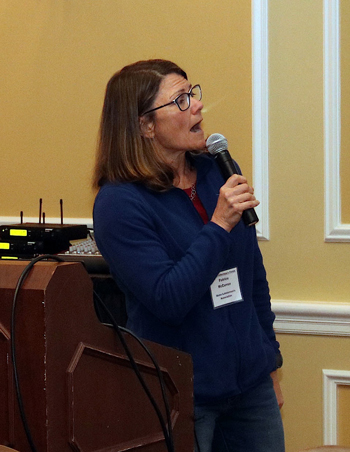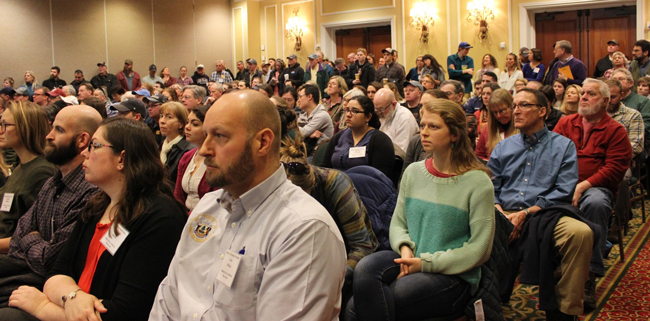Lobster Industry Grapples with Whales and Bait Crises
Continued from April 2019 Homepage

Patrice McCarron, MLA. “The majority of the loss is from Area 1A. That’s 77 million pounds of herring that won’t come into the fishery.” Mike Young photo
to test the strength of endlines and measure the strain on rope at sea. That project is expected to provide a baseline of endline rope strength, which will inform further actions, he said.
“The DMR is taking our rope and breaking it,” Porter said. “We’re finding out there’s a huge difference between rope that’s off the shelf and rope that’s a couple of years old. So we might not be that far off from where they want us to be.”
The MLA is working with the Maine delegation to oppose federal legislation, SAVE Right Whales Act of 2018 (S. 3038), introduced by U.S. Senators Cory Booker (D-NJ), Tom Carper (D-DE), Bill Nelson (D-FL), Bob Menendez (D-NJ) and Kirsten Gillibrand (D-NY) in June 2018. If passed, the bill establishes a new grant program to fund collaborative projects between states, nongovernmental organization, and members of the fishing and shipping industries to reduce the impacts of human activities on North Atlantic right whales.
The MLA also challenged a National Marine Fisheries Service (NMFS) memorandum that outlines challenges facing right whales.
“It basically puts all of the blame on us,” Porter said.
“We’re trying to focus
on the big issues in
the fishery, the ones
that can ruin us.”
– Kristan Porter, MLA
The MLA is monitoring a new right whale working group established by the Atlantic States Marine Fisheries Commission, he said.
And MLA held eight industry meetings along the Maine coast to inform the industry of the right whale situation and get its input on the types of mitigating strategies, such as ropeless fishing, it can and can’t live with, he said.
In 1997, he pointed out, there were only 295 right whales. Lobster fishing regulations were developed since then, resulting, by 2015, in an increase of the endangered population to 458 individuals. That number has declined since but, said Porter, “We feel it’s not by our doing.”
Mary Anne Mason, an attorney with Crowell & Moring, headquartered in Washington, D.C., who represents the MLA, offered an update on the legal situation around a lawsuit filed by a group of environmental non-governmental organizations (eNGO), in May 2018, against the National Oceanic and Atmospheric Administration (NOAA) and NMFS under the Endangered Species Act (ESA) and the Marine Mammal Protection Act (MMPA).

Barely standing room at the annual meeting of the Maine Lobstermen’s Association.
Discussions of the federal right whale entanglement lawsuit and deep cuts to the lobster bait supply dominated the meeting. Fishermen’s Voice photo
“They basically are alleging the government hasn’t done its job under either statute,” Mason said of the eNGOs. “Our strategy has been to intervene in the case, but we are not disputing or getting involved in the litigation between the government and the agencies. Instead, what we have is the right to get involved in the case. To the extent that the case develops information or starts to make decisions that could affect us, we will then have the right to put on the record the information that we think clarifies the reality of the situation.”
Due to the 35-day partial federal government shutdown, the case went nowhere during that time, Mason pointed out.
“But the government and the environmental groups are going forward with discovery,” she explained. “They’re committed to finishing that by the end of March or middle of April. Thereafter, the judge will set a schedule that will bring the parties to a hearing, probably in the fall.”
“Our strategy has been
to intervene in the case, ...
we will then have the right
to put on the record the information that we think
clarifies the reality of
the situation.”
– Mary Anne Mason,
Attorney for the MLA
In the meantime, Mason said, the MLA is hopeful that the rest of the take reduction team process will get ahead of that litigation.
The MLA has been working hard to get ahead of the impending bait crisis as well, said MLA Executive Director Patrice McCarron.
At issue is a 70 percent reduction in the Atlantic herring quota for 2019, to 15,000 metric tons.
“2018 was already a 50 percent reduction over previous years,” McCarron said. The majority of the loss is from Area 1A, which is where the majority of herring bait for the lobster fishery comes from. “That’s 77 million pounds of herring that won’t come into the fishery,” she said.
Federal regulators are considering further reductions for 2020 and 2021, to just under 10,000 metric tons.
“Bait that’s usually streaming in all summer and fall will basically disappear,” she said.
The quota reductions are based on findings in the resources last stock assessment of poor recruitment of young herring. The next stock assessment is scheduled for 2020.
“So hopefully the crisis will potentially abate,” said McCarron. “But who knows?”
The MLA advocated for a higher quota for 2019, which would have meant smaller quotas in 2020 and 2021, but would have given the industry time this year to identify alternate sources of bait, coordinate distribution, and grow infrastructure and storage capacity, she said. That position was rejected by federal regulators.
Just what the situation means for the bait supply is uncertain, she said.
Part of that, she said, is uncertainty about how much of other types of bait exists. Although bait suppliers have identified some 20 million pounds of bait for 2019, that leaves a gap of 50 million pounds, she said. Some have mentioned menhaden, also called pogies, as an alternative bait. But Maine’s portion of the menhaden quota is only 5,445 metric tons.
“So what does it mean? I don’t know,” she said. “It’s not good.”
Scarcity, price increases, and strain on other bait sources appear to be on the horizon, she said.
“We assume bait prices will skyrocket and product will be scarce,” she said. It’s possible that lobstermen in remote areas will be marginalized when it comes to the ability to source bait.
“We don’t want to respond
to a short-term crisis by
harming the long-term
interest of the fishery.”
– Patrice McCarron, MLA
Fishermen’s response, both individually and collectively, could help make a difference, she said. Topics to consider include reducing individual and co-op use of herring.
“How much strain will that remove?” McCarron said. “I hope people are thinking about that. We don’t know what the new inventory of bait will be. We don’t know the timing of availability of alternative bait. We don’t know the extent of bottlenecks in cold storage and transportation, to get it to Maine and distributed across the coast. We don’t know how the bait supply chain is preparing. A lot of this is proprietary information. There’s not a lot of transparency about what we’ll get or how it will work.”
An MLA survey of its members revealed a high level of concern, she said. When surveyed about solutions, 22 percent said the bait supply should be diversified and 18 percent recommend instituting lobster fishery seasons or closures in various forms. Many said lobstermen could use less bait, have longer sets, use bait saver bags, and wait longer into the season before setting traps. Some said they want to see effort reduction with fewer traps and/or days off, to reduce bait demand.
“As individual fishermen, you have to decide what your strategies will be,” she said.
With regard to alternatives, McCarron said, Maine has stringent regulations to ensure disease-free bait.
“You can’t just bring any bait in,” she said. “We don’t want to respond to a short-term crisis by harming the long-term interest of the fishery.”
The DMR is looking at the potential for various bait sources, including Illinois carp, Gulf of Mexico menhaden, alewives, hide bait, and new baits under development, like fish oils, fishmeal, and salmon grown by land-based farms.
The MLA awarded an Outstanding Service Award to Carl Wilson, director of the Department of Marine Resources’ Bureau of Marine Science. It awarded the Golden V-Notch Award to Dwight Carver of Beals Island, as someone who puts a lot of time not only into the fishery, but into his family and community.
